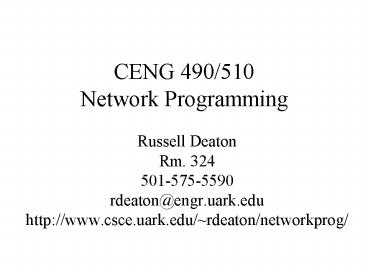CENG 490/510 Network Programming - PowerPoint PPT Presentation
1 / 26
Title:
CENG 490/510 Network Programming
Description:
Packet: A small, self-contained parcel of data sent across a computer network. ... Reliable delivery of data between computers. Layer 3: Network ... – PowerPoint PPT presentation
Number of Views:33
Avg rating:3.0/5.0
Title: CENG 490/510 Network Programming
1
CENG 490/510Network Programming
- Russell DeatonRm. 324501-575-5590rdeaton_at_engr.u
ark.eduhttp//www.csce.uark.edu/rdeaton/networkp
rog/
2
Why Network Programming?
- New Economy
- Software for Network Applications
- Client/Server Architecture
- Platforms?
3
Class Introduction
- Syllabus
- Topics
- Resources
- Requirements
- Grading
- Computer Accounts
- Introduction to the online resources(
http//engronline.ee.memphis.edu/ )
4
Networks
5
Common Xmit Media
6
Shared Media
- Networks are a shared communication resource
- Only one user can access at a time
7
Packet and Circuit Switched
- Circuit Public Telephone Network
- Packet Internet and US Mail
- Data divided into small units (packets) for
transmission - More efficient use of shared resource
8
Time-Division Multiplexing
9
Packets and Frames
- Packet A small, self-contained parcel of data
sent across a computer network. Each packet
contains a header that identifies the sender and
recipient, and data to be delivered. - Frame The form of a packet that the underlying
hardware accepts and delivers.
10
Frames
- Header and trailer indicates beginning and end of
frame.
11
Transmission Errors
- Error Detection and Error Correction
- Both require additional information beyond data,
appended to end of frame - Many Schemes
- Parity checking, Check Sum, CRC codes
- Error Correcting Codes Hamming, Reed-Solomon,
etc...
12
- Parity refers to the number of bits set to 1 in
the data item - Even parity - an even number of bits are 1
- Odd parity - an odd number of bits are 1
- A parity bit is an extra bit transmitted with a
data item, - chose to give the resulting bits even or odd
parity - Even parity - data 10010011, parity bit 1
- Odd parity - data 10010111, parity bit 0
13
Point-to-Point Networks
14
LANs
- Reduce complexity and cost by sharing
communication channel - TDM
- Synchronization
- Effective because of locality of reference
- Spatial
- Temporal
15
Topologies
- Star, Ring, Bus
16
Ethernet
- Widely used LAN technology
- Invented at Xerox PARC (Palo Alto Research
Center) in 1970s - Defined in a standard by Xerox, Intel and Digital
- DIX standard - Standard now managed by IEEE - defines formats,
voltages, cable lengths, ... - Uses bus topology
- Single coax cable - the ether
- Multiple computers connect
- One Ethernet cable is sometimes called a segment
- Limited to 500 meters in length
- Minimum separation between connections is 3
meters
17
- Originally 3 Mbs
- Currently, 10 Mbs
- Fast Ethernet, 100 Mbs
- One computer transmits at a time
- Signal is a modulated carrier which propagates
from transmitter in both directions along length
of segment
18
Hardware Adresses
- Identify destination on shared channel
- Hardware or physical address
- Included in frame
19
Ethernet Frame
20
(No Transcript)
21
WAN
- Packet Switch Moves complete packets from one
connection to another
22
(No Transcript)
23
Protocols and Layering
- A rule that specifies format and meaning of
messages that computers exchange - Protocols organized in layers, each of which
solves specific aspect of communication problem.
24
ISO 7 Layer Model
25
Layer 7 Application Application-specific
protocols such as FTP and SMTP (electronic mail)
Layer 6 Presentation Common formats for
representation of data Layer 5 Session
Management of sessions such as login to a remote
computer Layer 4 Transport Reliable delivery
of data between computers Layer 3 Network
Address assignment and data delivery across a
physical network Layer 2 Data Link Format of
data in frames and delivery of frames through
network interface Layer 1 Physical Basic
network hardware - such as RS-232 or Ethernet
26
Nested Headers































